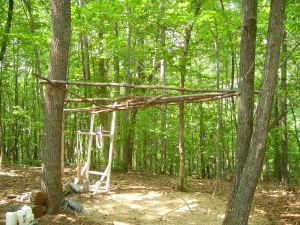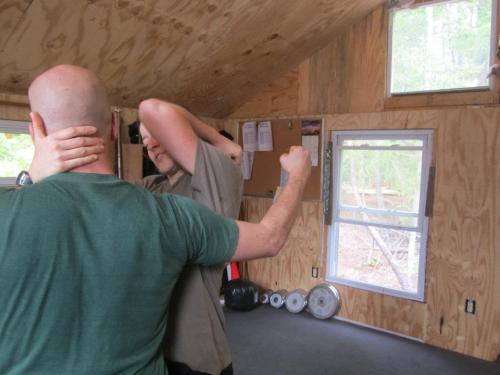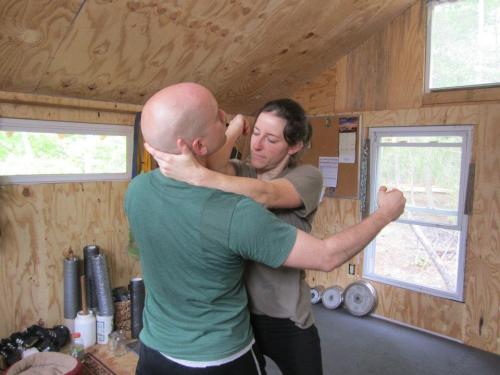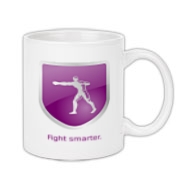When my wife and I began building our home a few years ago we needed a place to store our tools at the worksite. Living in a camper generally is not spacious as it is, and both of our cars were full of construction paraphenalia. So we decided to build a temporary lean-to out of saplings and a tarp until a more substantial shed could be built. At some point during all of this, I realized that the lean-to was in the perfect spot for an outdoor training area. It also lent itself well to serving as a framework upon which to attach all sorts of improvised punching targets. This idea took hold in my brain and mutated until I found myself with a grid work of swinging targets that provides excellent self-training for reaction skills and timing .
The more targets I added, the more difficult (read: fun) the challenge offered by the contraption became. Starting out dodging/striking one target is fairly simple. But once the other ones begin to move around, the number of objects in the visual field multiplies. Hitting target A is the goal, but targets B, C and D may be on their way back around to smack you. Hitting any one of them changes it’s trajectory and speed, requiring the user to track objects that may be out of the visual range while also focusing on the target at hand, hitting it and evading the ones that are moving in from several directions- a bit like overclocking the brain. Also a bit like trying to shuffle through a crowd, or deal with several people approaching at once. The targets are free to swing so the movements are fairly unpredictable, especially when several are moving at once. There are many, many possibilities for training with this setup, both solo and with partners. I will post some games and drills later on, but for now I will show the rebuilding process and it’s outcome. Obviously, saplings are a good, free building material for me- however, any suitable materials can be used indoors or out to make something that achieves the exact same goals.

The original grid.

Various targets from the grid.
As can be seen in the pic, the original was a bit low and not in the best of shape at the end. I tore it down and pulled out the poles that were still in good shape to be reused.

Frame in place.
The new one is 7″ high and attached to four trees as opposed to three, adding several feet of space to move in. The height also allows for targets to be moved to different levels as needed.

The first new cross members in place.

New grid completed from hardwood saplings, 2-3″ diameter. Many are from the original grid.

The reinforced grid, with several targets attached, ready to use. Tennis balls provide smaller, lighter targets to be evaded and parried; the larger targets are 2-liter soda bottles wrapped in foam sheeting and duct tape, secured via a knot through the bottom of the cap and filled with plain ol’ water. The bottle targets provide a suprisingly firm surface that will actually respond with more firmness the harder they are hit. The round shape requires proper hand/knuckle alignment to provide feedback, as a grazing blow will simply roll off. A good shot will knock it squarely away from the strike. And the best part is, they’re more or less free, easy to make and highly portable.
 Detail of a 2-liter soda bottle “maize bag.” Don’t be fooled- when filled with water, these are surprisingly dense and hard to hit cleanly
Detail of a 2-liter soda bottle “maize bag.” Don’t be fooled- when filled with water, these are surprisingly dense and hard to hit cleanly
Eventually I hope to have as many as a dozen different targets hanging off the grid. I’ll post more pictures as it develops. I also hope to get some good video of it being used to post as well, along with some of the games and drills- I will have several volunteers from Camp TKRI in just a few weeks….
Next up: a kakiya.



















 are available here.
are available here.